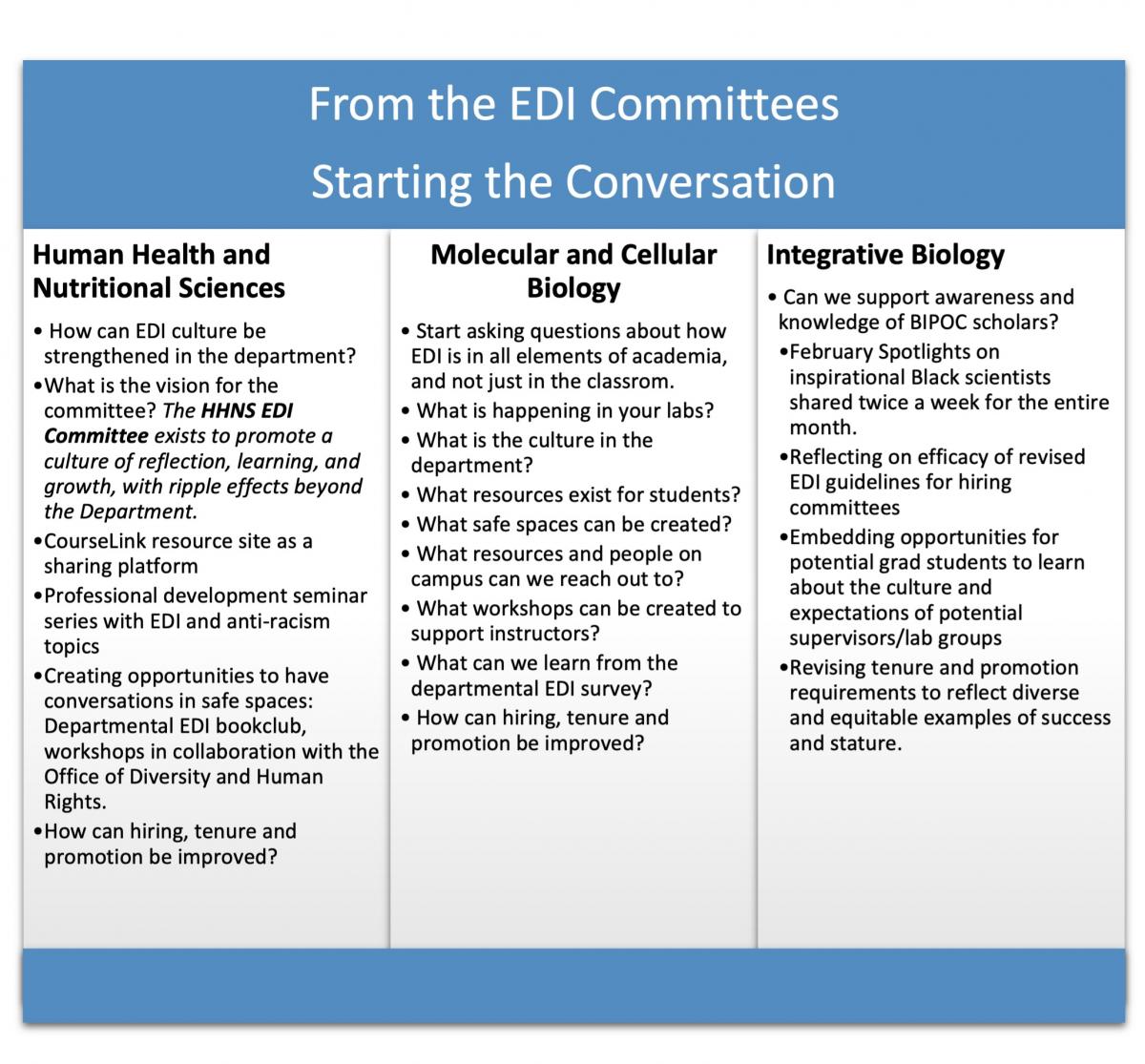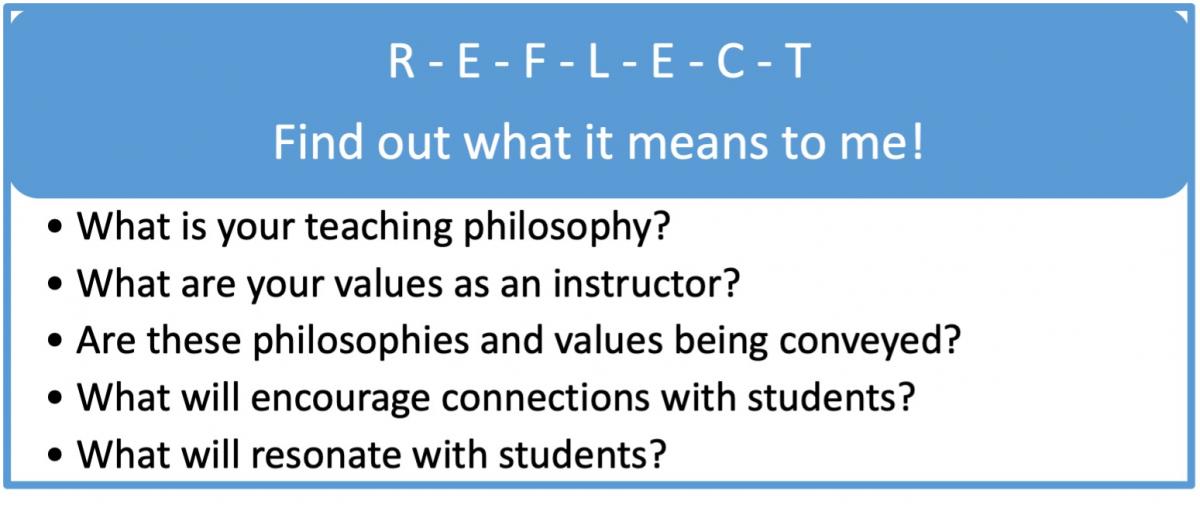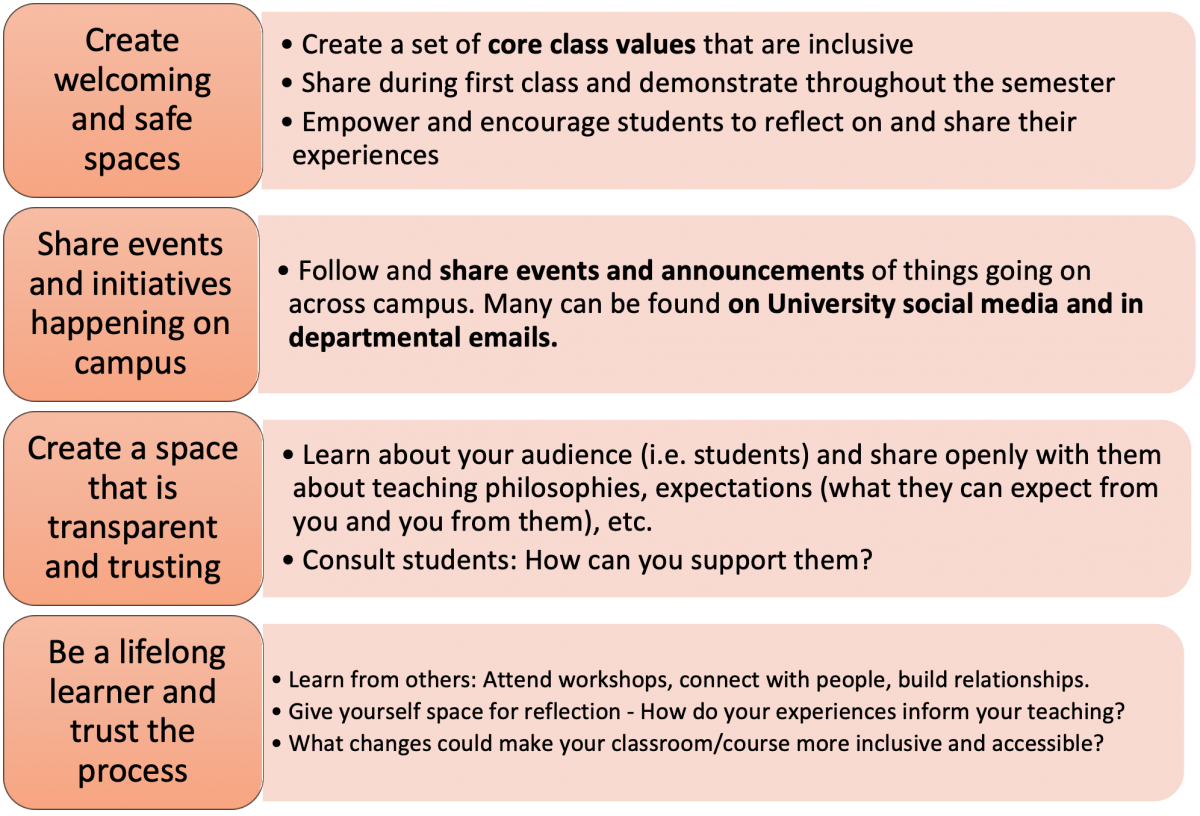Contents
- 1 We All Start Somewhere
- 2 Embracing Equity, Diversity & Inclusion – Who We Teach
- 3 Positionality of the Author
- 4 Classrooms Are Diverse, But How Do We Match That in Our Instructional Practices?
- 5 How are you feeling about the level of EDI in your courses/classroom?Where are you in your journey?
- 6 Can we all take a moment and reflect on the power educators have in creating inclusive learning spaces for students?
We All Start Somewhere
Words By: Jessi Nelson
In this article: Equity, diversity, and inclusion is happening across multiple levels within the College of Biological Science. The goal for this article is to share some of the departmental-level and classroom-level changes that are happening and how they can be brought into both the classroom and daily practices.
Find out more about:
- What’s happening in the three departmental EDI committees
- Experiences, thoughts, and tips for creating positive and inclusive classrooms
- Resources available to support you on your journey with EDI
Embracing Equity, Diversity & Inclusion – Who We Teach
Positionality of the Author
As the author of these Spotlights, the work, so far, has been relatively straight-forward. Having interviews and learning from educators across the departments in the College of Biological Science, and then sharing the amazing things they are doing. This feature is different. And it would not be proper for me to write on this important subject without first taking time to reflect and consider my positionality, and to share it with you, the reader.
As a white, gender fluid (non-binary/female) individual from a middle-class family, I have privilege. I have graduated from university and gained valuable experiences. However, during my undergrad, I did not have a good understanding of systemic barriers and inequity of opportunity and experience within Canada. I certainty understood that globally accessibility to opportunity differed, but the extent of the systemic inequities that were taking place around me daily were less obvious at the time. Unfortunately, I did not even realize the systemic barriers I was facing being a non-male, older student who was living with poor mental health. On many occasions I felt a great deal of stress and pressure to fit within some idealized standard of what it meant to be a good student or to be perceived as female. Many things have changed since I graduated in 2016. My mental health has improved with the support of counselling, and I know myself better. I also returned to university to complete a master’s thesis in the BioM research lab, guided by Dr. Shoshanah Jacobs. It has been an EPIC journey with many ups and downs. Most notably, I have gained a better understanding of systemic barriers. I think, for me, the biggest shock is the overwhelming permeation of systemic inequity that has woven its way through so many aspects of the system. Barriers to inclusion and accessibility are everywhere. That said, I believe we can change these exclusionary and hierarchical systems, and we can do so by taking action every day to learn from others, to have difficult conversations, to work together in unity. It is with this spirit of continually learning from others and continually taking actions towards change that I write the two EDI Spotlights for February and March. Jessi
Classrooms Are Diverse, But How Do We Match That in Our Instructional Practices?
What comes to mind when you think of Equity, Diversity, and Inclusion (EDI) in the classroom?
- Authentic methods of assessment and pre-testing (appreciation for unique student experiences)
- Celebrate the diversity in the classroom (mindfully and authentically)
- Anti-racism & anti-oppressive approaches, such as the creation of safe, welcoming spaces
- Acknowledging the vulnerability associated with learning and supporting the process
- Incorporating culturally inclusive contexts and examples, such as historical figures
- Prioritizing student agency and choice, and recognizing there are differences in how students perceive the content, class, and assignments
- Transparency and open communication by instructors/teaching team
- Considering and including mental health in class conversations
- Authentic incorporation of Indigenous Knowledge systems and world views
- Awareness of our unconscious/implicit biases and learning how to overcome them
- Flexible teaching format (remote, in-person, hybrid) and support for accommodations
- Being intentional in how you teach, especially for large classes, and to welcome/encourage conversation with students, with the goal of finding ways that support their success
- Removal of barriers to access and barriers to success
*This list was created with the support of many voices – A BIG THANK YOU, ALL OF YOU!!!!
What we can tell from this list, is there are many facets to EDI in the classroom, and while these conversations were taking place before the pandemic, our current world has certainly carried the conversation into the forefront of our minds. There is a sense of urgency and the more we have conversations, the more we can understand how EDI in the classroom can look for the inclusion and success of all individuals.
How are you feeling about the level of EDI in your courses/classroom?
Where are you in your journey?
What EDI means for each of us varies because we are all at different points along our journey and we all have our own unique educational experiences and teaching experiences. That said, we are not in an era of waiting to make a start. We can all play a role in making meaningful changes in our classrooms, courses, research labs, and daily lives.
The goal of this Spotlight feature is NOT to provide a perfect recipe for bringing EDI into the classroom, nor is it possible to cover everything being done by instructors, students, faculty, and staff in the College of Biological Science (CBS). Rather, the intention is to recognize that the journey is unique for each of us, and through awareness of what is already happening, to gain some insights about what we can do to support and make meaningful changes.
Can we all take a moment and reflect on the power educators have in creating inclusive learning spaces for students?
What’s Happening in the College of Biological Science?
The departments in the CBS each have Equity, Diversity, and Inclusion committees, and it is important to acknowledge that the committees are at different stages. The work happening is gradual and invites discourse and reflection. After all, changes must be meaningful and NOT performative. Some of what’s important is to learn, ask questions and start conversations. What resonates with you? Where can you make changes?
Insights from Departmental EDI Committees
- Principles of Belonging – Courselink self-directed course for all members of the department
- It has a paired follow-up workshop about what to do in the classroom – by Angela Guerra (guerra@uoguelph.ca) – “Call it out!”
- Land acknowledgements – bring those into your classroom in a meaningful way. It is not a formality. It is personal. It is reflective.
- EDI is about strengthening culture and relationships between people – assume the best in everyone.
- Start having dialogue whenever possible – reach out to the appropriate people
- Start asking questions – What can I do to learn more about what barriers exist for students? What students are most vulnerable? What can I do in the class?
- It goes beyond the classroom – includes research, hiring, tenure and promotion, mentorship, teaching, etc.
- Celebrate the successes of individuals from a diversity of backgrounds – Researcher Spotlights – everyone in the class needs an opportunity to be inspired by someone they can see themselves in.
When it comes to EDI and the classroom, we all have a role to play, from faculty and staff instructors to graduate teaching assistants, undergraduate teaching assistants, and volunteers. We can all do something to make our classrooms more inclusive, safe, and welcoming spaces for the diversity of students in them.
In part one of a two part workshop entitled, “Addressing Race in the Classroom: Improving the Student Experience,” Tameera Mohamed, the Cultural Diversity Advisor in the Cultural Diversity Office in Student Experience, shared some really powerful advice when it comes to EDI in the classroom, “When approaching teaching and learning, if you can design a course to meet the needs of the MOST barriered person in the room, you will meet the needs of everyone!”


Building Equity, Diversity, and Inclusion in the Classroom: Diagram constructed with insight from interviews with Dr. Jennifer Monk, Dr. Chris Meyer, Brad Howie, and Anti-Racism workshop led by Tameera Mohamed.
Support + Resources
Change Does Not Happen in Isolation
Diversity and Human Rights Office
- Equity, Diversity, and Inclusion COVID-19 Handbook (link to PDF)
- Some of the resources they have include:
- Multi-Faith Calendar, Training, Principles of Belonging, Accessibility (AODA) Resources, Positive Space Project, Plans, Reports & Surveys
Supporting the Needs of Black Students at the University of Guelph (2016)
Link to pdf: https://gryphlife.uoguelph.ca/organization/cdo/documents/view/22468
Supporting Black Students at U of G on Their Professional Path



